This article has multiple issues. Please help improve it or discuss these issues on the talk page. (Learn how and when to remove these messages)
|
| Vercingetorix | |
|---|---|
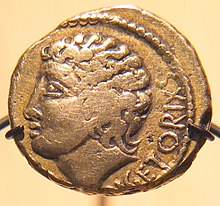 Gold stater of Vercingetorix, Cabinet des Médailles. This depiction is idealized and symbolic. Gold stater of Vercingetorix, Cabinet des Médailles. This depiction is idealized and symbolic. | |
| King of the Arverni | |
| Personal details | |
| Born | c. 80 BC Unknown |
| Died | 46 BC (aged 36–37) Rome, Italy, Roman Republic |
| Cause of death | Execution by strangling |
Vercingetorix (Latin: [wɛrkɪŋˈɡɛtɔriːks]; Ancient Greek: Οὐερκιγγετόριξ [u.erkiŋɡeˈtoriks]; c. 80 – 46 BC) was a Gallic king and chieftain of the Arverni tribe who united the Gauls in a failed revolt against Roman forces during the last phase of Julius Caesar's Gallic Wars. After surrendering to Caesar and spending almost six years in prison, he was executed in Rome.
Vercingetorix was the son of Celtillus the Arvernian, leader of the Gallic tribes. Vercingetorix came to power after his formal designation as chieftain of the Arverni at the oppidum Gergovia in 52 BC. He immediately established an alliance with other Gallic tribes, took command, combined all forces and led them in the Celts' most significant revolt against Roman power. He won the Battle of Gergovia against Julius Caesar in which several thousand Romans and their allies were killed and the Roman legions withdrew.
Caesar had been able to exploit Gaulish internal divisions to easily subjugate the country, since Vercingetorix's attempt to unite the Gauls against Roman invasion came too late. At the Battle of Alesia, also in 52 BC, the Romans besieged and defeated his forces. To spare as many of his men as possible, he gave himself to the Romans. He was held prisoner for five years. In 46 BC, as part of Caesar's triumph, he was paraded through the streets of Rome and then executed by garroting. Vercingetorix is primarily known through Caesar's Commentarii de Bello Gallico (Commentaries on the Gallic War). He is considered a folk hero in France, and especially in Auvergne, his native region.

Name
The Gaulish name Vercingetorix can be literally translated as 'great king' or 'leader of warriors', from ver- ('over', 'superior') + -cingeto- ('warrior, hero') + -rix ('king'). Scholar Maigréad Ní C. Dobbs has proposed to see an Irish cognate of the name in the form Ferchinged an rí. In his Life of Caesar, Plutarch renders the name as Vergentorix (Ουεργεντοριξ). According to Florus, he was "endowed with a name which seemed to be intended to inspire terror".
Background
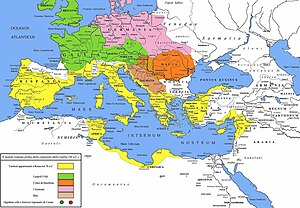

Having been appointed governor of the Roman province of Gallia Narbonensis (modern Provence) in 58 BC, Julius Caesar proceeded to conquer the Gallic tribes beyond over the next few years, maintaining control through a careful divide and rule strategy. He made use of the factionalism among the Gallic elites, favouring certain noblemen over others with political support and Roman luxuries such as wine. Attempts at revolt, such as that of Ambiorix in 54 BC, had secured only local support, but Vercingetorix, whose father, Celtillus, had been put to death by his own countrymen for seeking to rule all of Gaul, managed to unify the Gallic tribes against the Romans and adopted more current styles of warfare.
Averni nobleman
The revolt that Vercingetorix came to lead began in early 52 BC while Caesar was raising troops in Cisalpine Gaul. Believing that Caesar would be distracted by the turmoil in Rome following the death of Publius Clodius Pulcher, the Carnutes, under Cotuatus and Conetodunus, made the first move, slaughtering the Romans who had settled in their territory.
Vercingetorix, a young nobleman of the Arvernian city of Gergovia, roused his dependents to join the revolt, but he and his followers were expelled by Vercingetorix's uncle Gobanitio and the rest of the nobles because they thought that opposing Caesar was too great a risk. Undeterred, Vercingetorix raised an army of the poor, took Gergovia, and was hailed as king.
War with Rome
| This section does not cite any sources. Please help improve this section by adding citations to reliable sources. Unsourced material may be challenged and removed. (September 2022) (Learn how and when to remove this message) |
Vercingetorix made alliances with other tribes, and in doing so he united Gaul under the pretense of escaping Roman rule. After having been unanimously given supreme command of their armies, he imposed his authority through harsh discipline and the taking of hostages. Leadership and unification on this level was unprecedented in Gaul and would not happen again for decades.
He adopted a policy of retreating to natural fortifications, and undertook an early example of a scorched earth strategy by burning towns to prevent the Roman legions from living off the land. Vercingetorix scorched much of the land marching north with his army from Gergovia in an attempt to deprive Caesar of the resources and safe haven of the towns and villages along Caesar's march south.
Siege of Avaricum
However, the capital of the Bituriges, Avaricum (near modern-day Bourges), a Gallic settlement directly in Caesar's path, was spared. Due to the town's strong protests, naturally defensible terrain, and apparently strong man-made reinforcing defenses, Vercingetorix decided against razing and burning it. Leaving the town to its fate, Vercingetorix camped well outside of Avaricum and focused on conducting harassing engagements of the advancing Roman units led by Caesar and his chief lieutenant Titus Labienus. Upon reaching Avaricum, however, the Romans laid siege and eventually captured the capital.
Afterwards, in a reprisal for 25 days of hunger and of laboring over the siegeworks required to breach Avaricum's defenses, the Romans slaughtered nearly the entire population, some 40,000 people, leaving only about 800 alive.
Battle of Gergovia
The next major battle was at Gergovia, capital city of the Arverni. During the battle, Vercingetorix and his warriors crushed Caesar's legions and allies, inflicting heavy losses. Vercingetorix then decided to follow Caesar but suffered heavy losses (as did the Romans and their allies) during a cavalry battle and he retreated and moved to another stronghold, Alesia.
Battle of Alesia
In the Battle of Alesia in September 52 BC, Caesar built a fortification around the city to besiege it. However, Vercingetorix had summoned his Gallic allies to attack the besieging Romans. These forces included an army of Arverni led by Vercingetorix's cousin Vercassivellaunos and an army of 10,000 Lemovices led by Sedullos.
With the Roman circumvallation surrounded by the rest of Gaul, Caesar built another outward-facing fortification (a contravallation) against the expected relief armies, resulting in a doughnut-shaped fortification. The Gallic relief came in insufficient numbers: estimates range from 80,000 to 250,000 soldiers. Vercingetorix, the tactical leader, was cut off from them on the inside, and without his guidance the attacks were initially unsuccessful. However, the attacks did reveal a weak point in the fortifications and the combined forces on the inside and the outside almost made a breakthrough. Only when Caesar personally led the last reserves into battle did he finally manage to prevail. This was a decisive battle in the creation of the Roman Empire.
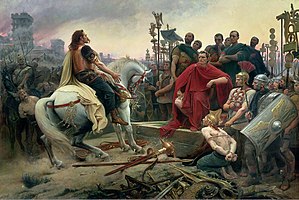
According to Plutarch, Caes. 27.8-10, Vercingetorix surrendered in a dramatic fashion, riding his beautifully adorned horse out of Alesia and around Caesar's camp before dismounting in front of Caesar, stripping himself of his armor and sitting down at his opponent's feet, where he remained motionless until he was taken away. Caesar provides a first-hand contradiction of this account, De Bell. Gal. 7.89, describing Vercingetorix's surrender much more modestly.
Imprisonment and death

Vercingetorix was imprisoned in the Tullianum in Rome for almost six years before being publicly displayed in the first of Caesar's four triumphs in 46 BC. He was ceremonially strangled at the Temple of Jupiter Optimus Maximus after the triumph. A plaque in the Tullianum indicates that he was beheaded in 49 BC.
Legacy
Memorials
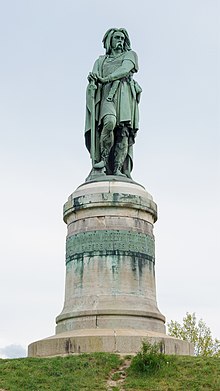
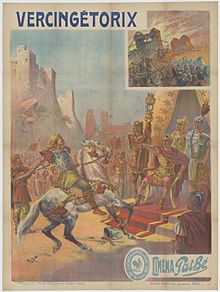
Napoleon III erected a 7-metre-tall (23 ft) Vercingétorix monument in 1865, created by the sculptor Aimé Millet, on the supposed site of Alesia. The architect for the memorial was Eugène Viollet-le-Duc. The statue still stands. The inscription on the base, written by Viollet-le-Duc, which copied the famous statement of Julius Caesar, reads (in French):
|
La Gaule unie |
Gaul united, |
Many other monumental statues of Vercingetorix were erected in France during the 19th century, including one by Frédéric Bartholdi on the Place de Jaude in Clermont-Ferrand.
Asteroid
Asteroid 52963 Vercingetorix, discovered by the OCA–DLR Asteroid Survey, was named in his honor. The official naming citation was published by the Minor Planet Center on 25 September 2018 (M.P.C. 111800).
Comics
Vercingetorix is referenced and appears in flashbacks in several Asterix comics. Asterix and the Chieftain's Shield is about Asterix and Obelix's efforts to locate Vercingetorix's missing shield and humiliate Caesar in the process.
He is the co-protagonist and title character of the 18th book in the series The Adventures of Alix.
The story of his battles against Caesar and subsequent surrender are also referenced in Classics Illustrated "Caesars Conquests", which is an illustrated summation of "Caesar's Gallic Wars", written by Caesar.
TV
The 2005–2007 HBO series Rome depicts the surrender and execution of Vercingetorix.
Film
The 2001 film Druids, starring Christopher Lambert as Vercingetorix, depicts the Gallic chieftain's struggle against Caesar. The film is infamous in France for its poor quality and dismal box office performance. The script was written by Norman Spinrad, who also authored the novelization The Druid King.
"Caesar the Conqueror", a 1962 Italian movie, stars Rik Battaglia as Vercingetorix and Cameron Mitchel as Julius Caesar. The movie centers around Caesar's battles with the Gauls as well as his political battling in Rome. The movie ends with the Battle of Alesia and Vercingetorix's subsequent surrender.
Opera
Joseph Canteloube composed an opera, Vercingétorix, about the defeat of the Gauls by Julius Caesar. The libretto was by Étienne Clémentel. The Paris Opéra gave the first performance on 22 June 1933.
See also
- Ambiorix
- Alaric I
- Ardaric
- Arminius
- Autaritus
- Battle of Baduhenna Wood
- Bato (Daesitiate chieftain)
- Boudica
- Caratacus
- Fritigern
- Gainas
- Gaius Julius Civilis
- John of Gothia
- Spartacus
- Totila
- Tribigild
- Viriathus
References
- Bakker, Marco. "Reportret: Vercingetorix". www.reportret.info. Retrieved 1 April 2018.
- Goudineau 2009, p. 278.
- "France: The Roman conquest". Encyclopædia Britannica Online. Encyclopædia Britannica. Retrieved April 6, 2015.
Because of chronic internal rivalries, Gallic resistance was easily broken, though Vercingetorix's Great Rebellion of 52 BC had notable successes.
- "Julius Caesar: The first triumvirate and the conquest of Gaul". Encyclopædia Britannica Online. Encyclopædia Britannica. Retrieved February 15, 2015.
Indeed, the Gallic cavalry was probably superior to the Roman, horseman for horseman. Rome's military superiority lay in its mastery of strategy, tactics, discipline, and military engineering. In Gaul, Rome also had the advantage of being able to deal separately with dozens of relatively small, independent, and uncooperative states. Caesar conquered these piecemeal, and the concerted attempt made by a number of them in 52 BC to shake off the Roman yoke came too late.
- Evans 1967, pp. 121–122.
- Delamarre 2003, p. 116.
- Matasović 2009, pp. 200, 398.
- Dobbs, Maighréad Ní C. (1952). "Le nom de Vercingétorix en Irlande". Études celtiques. 6 (1): 195. doi:10.3406/ecelt.1952.1251.
- Plutarch, Life of Caesar 25; 27.
- Florus, Epitome of Roman History, 1:45.
- Julius Caesar, Commentaries on the Gallic War Book VII, sect. 4.
- "Vercingetorix". penelope.uchicago.edu. Retrieved 2022-11-12.
- Julius Caesar, Commentaries on the Gallic War vii.
- "The Internet Classics Archive | Caesar by Plutarch". classics.mit.edu. Retrieved 2021-03-31.
- Plutarch's Lives; Caes. 27.8-10; Flor. 1.45.26; Dio 40.41.3. Medieval French historians are also partly responsible for romanticising Vercingetorix's surrender. Romancing the Past: The Rise of Vernacular Prose Historiography in Thirteenth-Century France, by Gabrielle M. Spiegel, page 143, Berkeley: 1993.
- Plutarch. "The Life of Julius Caesar". The Parallel Lives. Loeb Classical Library Edition. Retrieved 15 July 2015.
- Commentaries on the Gallic Wars, Everyman's Edition, 1953 (Trans: John Warrington); Book VII, sect. 89.
- Dio 40.41.3, 43.19.4
- Statue of Vercingetorix Archived 2007-03-10 at the Wayback Machine, Art and Architecture, 2006
- Dietler, Michael, "Our ancestors the Gauls": archaeology, ethnic nationalism, and the manipulation of Celtic identity in modern Europe Archived 2016-03-04 at the Wayback Machine (7.3M), American Anthropologist, 1994, 96: 584–605. Dietler, M., A tale of three sites: the monumentalization of Celtic oppida and the politics of collective memory and identity, World Archaeology, 1998, 30: 72–89.
- "52963 Vercingetorix (1998 TB16)". Minor Planet Center. Retrieved 17 October 2018.
- "MPC/MPO/MPS Archive". Minor Planet Center. Retrieved 17 October 2018.
- Simeone, Nigel (2005). "France and the Mediterranean". In Cooke, Mervyn (ed.). The Cambridge Companion to Twentieth-Century Opera. Cambridge: Cambridge University Press. p. 136–138. ISBN 9780521780094.
Primary sources
- Julius Caesar, Commentarii de Bello Gallico Book 7
- Dio Cassius, Roman History 40:33–41, 43:19
- Plutarch, Life of Caesar 25–27
Bibliography
- Delamarre, Xavier (2003). Dictionnaire de la langue gauloise: Une approche linguistique du vieux-celtique continental. Errance. ISBN 9782877723695.
- Evans, D. Ellis (1967). Gaulish Personal Names: A Study of Some Continental Celtic Formations. Clarendon Press. OCLC 468437906.
- Goudineau, Christian (2009). Le dossier Vercingétorix. Actes Sud. ISBN 978-2-7427-8556-8.
- Matasović, Ranko (2009). Etymological Dictionary of Proto-Celtic. Brill. ISBN 9789004173361.
External links
- A reconstructed portrait of Vercingetorix, based on historical sources, in a contemporary style.
- Curchin, Leonard A. Lingua Gallica (The Gaulish Language). Retrieved January 23, 2010 from Uwaterloo.ca Archived 2010-09-25 at the Wayback Machine
- , Vercingétorix : le politique, le stratège. Paris : Perrin, 2000, 260 p. ISBN 2-262-01691-7.